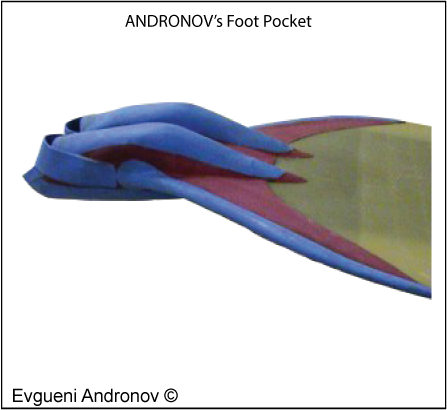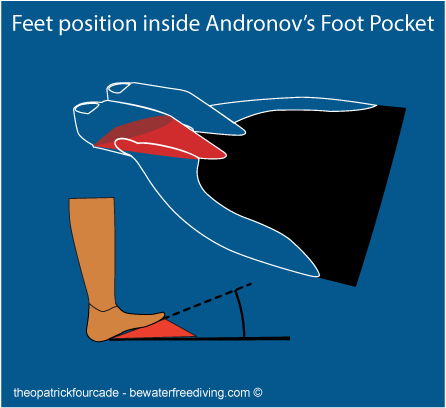Foot Pockets
The first improvements of the monofin concerned only the blade; foot pockets did not seem to be a priority. When I started finswimming in 1991, foot pockets were always made from transformed rubber bifins (cut, sanded, and shaped).

In 1999-2000, Evgueni Andronov, a Russian monofin maker, created a “revolutionary” foot pocket. The swimming performances made with this foot pocket confirmed a new development and a new technological revolution in the monofin world. This new model of monofin quickly became vital to athletes who wanted to stay competitive because it enhances performances in all of the finswimming disciplines.

This revolutionary foot pocket was designed to be more comfortable and fit the feet better. My first thought was that this new foot pocket acted as a “lever arm” for the blade: the feet were no longer in direct contact with the blade (like in previous models) and they seemed to be slightly set back. What is interesting to me is the angle in which the feet are positioned.

It is unimaginable how much this innovative change in foot pockets
Why?
You have to keep in mind that some anatomic predispositions give a real advantage to those who have them. Here, I am talking about the natural flexibility of the ankle and the foot, which creates an open- or closed-angle between the leg and the top part of the foot when ankle and foot are fully extended with pointed toes.
Some athletes have this angle more open (more flexible) than others, and this is a real advantage because it allows the swimmer to have the blade of the monofin in an optimal position to have an efficient propulsive phase. A closed-angle forces the swimmer to bend their knees in order to allow the blade to reach a good position. Unfortunately, bending the knees creates resistances and water drag. This is a major disadvantage when one thinks of hydrodynamics, slide, and inertia…

(When closed-angle the blade is not in a good position to start the propulsive phase).
The new foot pockets

(Even with a closed-angle the new foot pockets improve the blade orientation).
The new foot pockets allowed a kind of democratization process of the performances in finswimming and helped the growing use of the monofin in freediving.
The “wings”
– Give better control of the blade deformation during propulsive phases
– Help the blade come back to an upper position with less effort (for DYN) because the wings are made of foam (the foam float).
– With the inertia, the shape of the wing acts
– The shape of the wing (airplane wing/water drop) also accelerates the water flow.
Rubber strips, or the “rails”
If you have a lack of control over the monofin, your blade can move from right to left or left to right (during the front-kick in CWT or the kick-down in DYN), which doesn’t push through the water effectively, instead sliding through the water without the propulsive effects. This move of the monofin forces you to use more energy to correct your stability. The rubber strips, or “the rails”, easily correct the problem; they direct the water flow and maintain the blade in the correct position, thus allowing you to focus only on the best way to push on the blade.
NB :
Technological innovations are real gifts for athletes, but you still need to identify these innovations in order to use them to their greatest advantages.
Beginners who use a monofin with these new kinds of foot pockets, wings and rubber strips (rails) without having learned basic monofin technique, use a “shortcut.” The freediver compensates for flaws in technique by taking advantage of technological innovations. Unfortunately, because of this lack of knowledge and lack of
Some freedivers achieve amazing performances in CWT and DYN with an average monofin technique, a bad monofin technique or no monofin technique at all. You might ask: “Do I need to have good technique to perform?” It would be better to ask the following question instead: “What kind of performances would I be able to achieve and how fresh would I feel afterwards if I were to master the monofin technique?”
So…
GO PRACTICE !
Theo-Patrick FOURCADE
Next post: Technique and Style (definitions)
You are welcome to use information from the blog, but please specify the source with a link: Theo-Patrick FOURCADE – bewaterfreediving.com ©
All the illustrations are copyright ©, please ask me before use.

